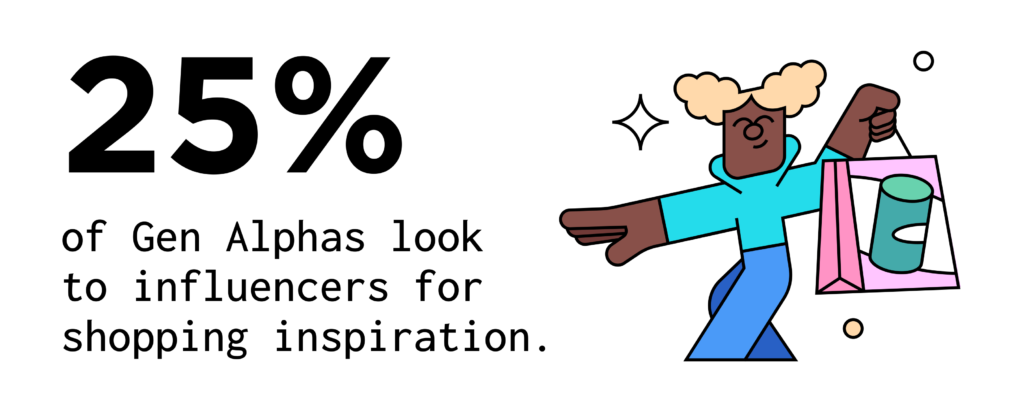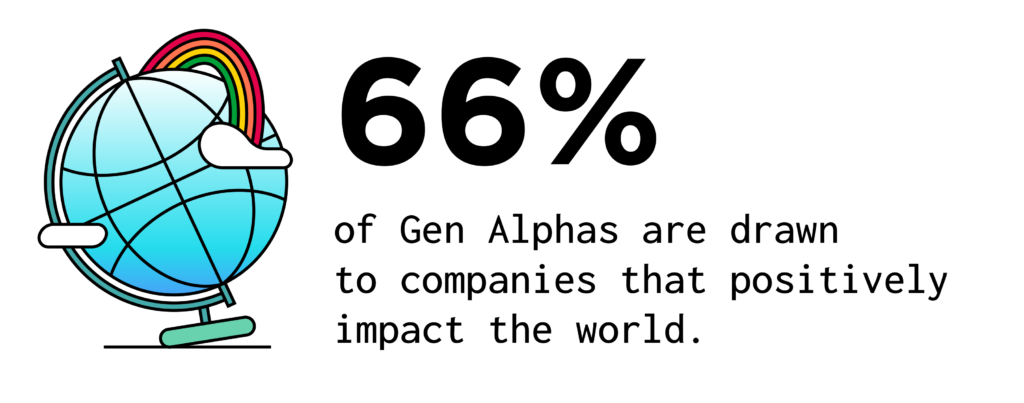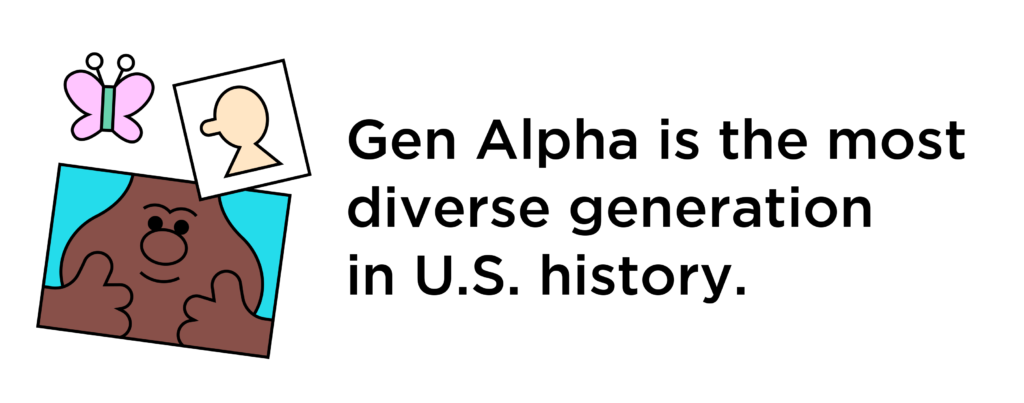Welcome to a new era. TikTok reigns supreme. Sustainability isn’t just a buzzword. And soon Gen Alpha will steer the marketing spaceship with their tech-savvy hands and socially conscious minds. As marketers, staying ahead of the curve requires understanding the nuances of the youngest generation on the block. That means having the Gen Alpha stats on lock.
We’ve rounded up six key trends that sum up the Gen Alpha stats you need to know. So, grab your avocado toast (Millennials, we’re looking at you), and let’s dive into the stats shaping the future of influencer marketing.

1. A Generation of Digital Natives
Gen Alpha refers to those born between 2010 and 2024. The oldest among them are only 14 years old at the time of this writing. Born into a world where technology is more commonplace than playgrounds, Generation Alpha is not just comfortable with tech; they’re practically cyborgs. Even more so than their Gen Z older siblings, Gen Alphas are true digital natives.
With over 2.8 million of them being born worldwide each week as of 2024, their influence is growing at an exponential rate. In the US alone, 13 percent of the population is Gen Alpha, marking them as a significant demographic force.
STREAMING SAVANTS
On average, Gen Alpha juggles 4.2 streaming services. They often choose screens over swings, with 59 percent naming TV and movies as their favorite weekend activity. 50 percent say watching TV and movies is their favorite after-school activity. But they aren’t just watching from home. Nearly one-third of 8-11-year-olds visit the movie theater monthly. And half say they like to watch movies as soon as they come out.
Comedies and cartoons are at the top of Gen Alpha’s watch list. A healthy majority tune into both. In fact, 62 percent say they watch comedies and 60 percent watch cartoons. Younger kids love shows that get them moving. It’s no surprise 34 percent of Gen Alphas groove to TV shows they can dance along to. And 33 percent tune in to shows that make them want to sing. In fact, music is the fastest-growing TV genre among Gen Alpha.
Sports shows follow close behind, with 30 percent watching. And 26 percent of Gen Alphas indulge in cooking shows.
Never underestimate the power of sibling influence. A notable 27 percent of Gen Alphas watch what their brothers and sisters watch. Sometimes the remote control is mightier than the algorithm.
Sad and serious dramas rank the lowest for Gen Alpha viewers, with only 5 percent tuning in. So if you want to appeal to the kids, make content that gets them laughing, singing, or dancing.
GEN ALPHA’S TIKTOK TAKEOVER

It’s important to note that many apps, like TikTok and Instagram, require users to be at least 13 years old. With Gen Alpha ranging from 0 to 14 years old, it can be hard to find data on Gen Alpha social media usage. Often the demographic’s stats are looped in with the youngest Gen Zers, older teens
TikTok has unequivocally captured the spotlight in the realm of social media, emerging as the favorite platform among 13 to 15-year-olds. One in five name it as their app of choice. This trend highlights TikTok’s significant influence on youth culture and engagement strategies. Its popularity continues to surge with an 18 percent increase in engagement year over year.
TikTok seems to set the tone for the future of social media and entertainment. This dynamic digital engagement powerhouse shapes youth culture and marketing engagement strategies. If you’re looking to market to Gen Alpha, a TikTok-style short-form video may be the way to go.
Almost all children aged 3 to 17 (96 percent) watch videos on video-sharing sites and apps. More than half of all youngsters view live-streamed video content (58 percent).
According to Sprout Social, although YouTube is widely used across all age groups, TikTok becomes increasingly popular as children get older. Here’s a breakdown of TikTok usage based on age range:
- 19% of 3-4-year-olds
- 25% of 5-7-year-olds
- 52% of 8-11-year-olds
- 78% of 12-15-year-olds
2. Socially Conscious Shoppers
Generation Alpha cares about more than digital consumption. They’re setting new standards for corporate responsibility and ethical consumption.
THE POWER OF PURPOSE
A staggering 66 percent of Gen Alphas are drawn to companies that positively impact the world. This preference echoes in their anticipation of wielding their own purchasing power. They’re not just future consumers. They’re future changemakers, with a keen eye for sustainable materials and practices.
THE INFLUENCE OF INFLUENCERS ON GEN ALPHA
According to Demandsage, influencers wield a significant influence on Gen Alpha’s shopping behaviors. In fact, 25 percent of Gen Alphas turn to social media personalities for shopping inspiration. This percentage trails slightly behind the 28 percent who draw inspiration from their friends. It seems word-of-mouth advertising will continue to persist even among younger generations.

A substantial 55 percent of Gen Alphas express a desire to purchase products endorsed by their favorite YouTube or Instagram influencers. This trend not only highlights the pivotal role of influencers in shaping the preferences and purchase decisions of this young demographic. It also underscores the evolving dynamics of influencer marketing, emphasizing its potential to influence consumer behaviors from a remarkably young age.
3. A Blend of Online and Outdoor
Despite their adeptness with digital technology, 47 percent of Gen Alphas seek a harmonious balance between screen time and outdoor activities. This reflects a possible shift away from the rising trends of smartphone and social media addiction. This preference for spending time outdoors is further emphasized by the fact that slightly more Gen Alphas would rather be outside (27 percent) than indoors (26 percent). A significant 46 percent also express aspirations to pursue careers that allow them to embrace the great outdoors.
This inclination towards outdoor lifestyles underscores the vital need for marketing strategies to resonate with this demographic’s appreciation for nature and outdoor activities. It highlights an essential pivot in engaging with a generation that values the blend of digital connectivity and real-world experiences.
4. Equality and Sustainability
Gen Alpha values equality, environmental stewardship, and the universal right to basic necessities. A vast majority, 93 percent, of Gen Alpha champion acceptance. A similar majority advocate for access to food and housing, according to Canvas8. The Gen Alpha worldview is markedly inclusive and compassionate.
A staggering 66 percent of Gen Alphas demonstrate a preference for purchasing from companies that positively impact the world. Of course, the majority of Gen Alpha don’t currently have purchasing power as they are minors, but 82 percent report that they eagerly anticipate having their own money for personal spending.

This discerning demographic is also inclined towards sustainability. 18 percent specifically favor products crafted from sustainable materials. Such environmentally conscious attitudes are mirrored in the broader teen population. Nearly half of teens engage with environmental or climate change issues. This collective eco-awareness among Gen Alphas sends a compelling message to brands about the importance of amplifying their sustainability efforts to attract this next generation of buyers. Conscientious and sustainable practices play a pivotal role in resonating with young, values-driven consumers.
5. Financially Forward-Thinking
The financial literacy and autonomy of Gen Alpha have seen a marked boost. Gen Alpha bank account access increased 7 percent over the past year. This indicates that nearly one-third of global teens now have their own bank accounts.
Financial services tailored for this demographic, like Greenlight’s debit cards for kids and teens, have facilitated this trend. This is evidenced by the $225 million collectively saved in Greenlight accounts in 2021 alone. The growing financial inclusion highlights Gen Alpha’s eagerness to manage their own finances. It also opens up fresh opportunities for products and services designed to meet the needs of young savers and spenders.
6. Diverse and Determined
As the most diverse generation in US history, Gen Alpha epitomizes the broader societal shift towards greater diversity. US census data reveals that 47 percent of American children identify as non-white. This diversity is more than a mere statistic. It profoundly influences Gen Alpha’s worldview. It affects their expectations from brands, content, and experiences.

Marketers are thus tasked with the challenge of crafting inclusive and culturally sensitive strategies that resonate across a generation for whom diversity is not just a backdrop but a central aspect of their identity and expectations.
Gen Alpha Stats in Conclusion
We hope these Gen Alpha stats help you navigate the complexities of marketing to a generation that’s both digitally native and deeply concerned with social issues. When it comes to Gen Alpha, one thing is clear. Authenticity, sustainability, and inclusivity are essential.
Whether you’re crafting your next campaign or shaping your product development strategy, remember: Gen Alpha is watching. And they’re not afraid to demand more from the brands vying for their attention. Welcome to the future, where the kids are alright, and they’re reshaping the world one TikTok at a time.
If you’re tailoring your next influencer marketing campaign to target Gen Alpha, we can help. Schedule a strategy call with us today and we’ll help you market to this digitally native generation in a way that suits your goals. We’ve got all the Gen Alpha stats you need and the strategies to put them into action.

ABOUT THE AUTHOR
Abigail Welcom | Marketing Magician
Abby wins hearts and gains trust as our Brand Marketing & Outreach Coordinator. She puts her Film and Television Production degree to good use dreaming up visual marketing for The Shelf. When she’s not dazzling us with out-of-the-box ideas, you can likely find her at The Happiest Place on Earth — Disneyland!


